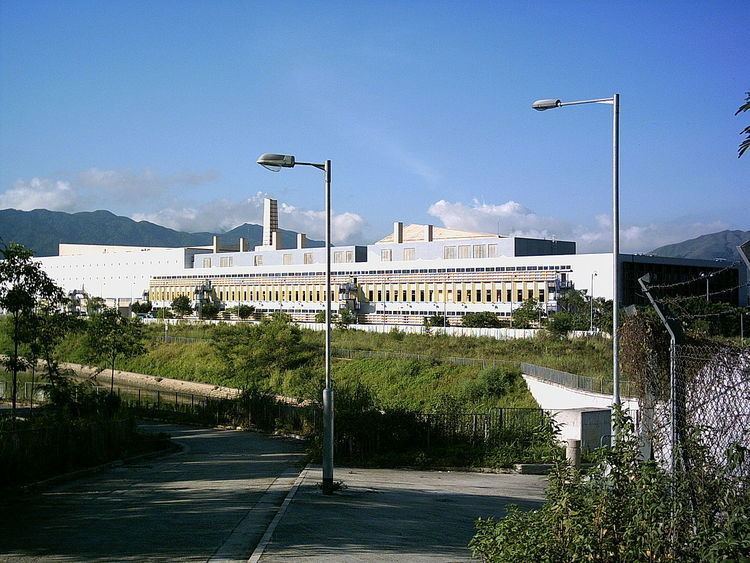Status Complete Completed June 1999 | Type Abattoir Floor count 3-4 Opened June 1999 Construction started 18 February 1997 | |
 | ||
Hours Open today · 6:30AM–8:45PMSaturday6:30AM–8:45PMSunday6:30AM–8:45PMMonday6:30AM–8:45PMTuesday6:30AM–8:45PMWednesday(Qingming Festival)6:30AM–8:45PMHours might differThursday6:30AM–8:45PMFriday6:30AM–8:45PMSuggest an edit Similar Cattle Depot Artist Village, Sheung Shui Station, Lo Wu Station, Kennedy Town Station, Belcher Bay Park | ||
sheung shui slaughterhouse cycling in hong kong
The Sheung Shui Slaughterhouse (Chinese: 上水屠房; Jyutping: soeng6 seoi2 tou4 fong4) is a slaughterhouse in the outskirts of Sheung Shui, New Territories, Hong Kong. The installation was built by China State Construction. Construction began on February 1997, at a cost of HK$ 1.858 billion. It covered 5.8 hectares, and was claimed to be the largest in Asia by the Architectural Services Department.
Contents
As of January 2000, pollution and hygienic controls of the slaughterhouse conform to international standard, and received ISO 14001 environmental management certification. The slaughterhouse is currently managed and operated by Ng Fung Hong Limited, who were contracted by the Hong Kong Government.
Today, the slaughterhouse can accommodate 12,000 pigs and 2200 cows. It is outfitted with sewage treatment, a water recycling plant and advanced slaughter machines which can operate mostly without manpower. The facility can slaughter up to 5000 pigs, 400 cows and 300 lambs per day.
History
The Sheung Shui Slaughterhouse replaced older slaughterhouses in Kennedy Town, Cheung Sha Wan and Yuen Long, which were closed for economic reasons as well as their proximity to urban areas. Reprovisioning the three abattoirs in a more remote area allowed the government to open 4.19 hectares of land for redevelopment of a type "more compatible with the surrounding areas". Additionally, the location in Sheung Shui, near the border with mainland China, allows livestock to be offloaded immediately after crossing the Hong Kong border, negating the need to run noisy and smelly livestock trains through developed areas.
Construction of the slaughterhouse commenced on 18 February 1997. It was substantially completed in June 1999 and fully commissioned by March 2000.
Description
The slaughterhouse is a complex of several interconnected blocks.
The designed daily throughput of the facility is 5,000 pigs, 100 suckling pigs, 400 cattle and 300 goats.
There is an underground wastewater treatment plant of approximately 9,500 square metres. It can treat 5,000 square metres of wastewater per day. The effluent from the slaughterhouse is 10 times more concentrated than domestic effluent, so the on-site treatment plant uses bacteria and micro-organisms to treat the wastewater to domestic standard before discharging it to the adjacent Shek Wu Hui Sewage Treatment Works for final treatment.
The abattoir incorporates several green features. A solar hot water system, comprising 450 solar panels on the rooftop of the meat despatch block, helps meet the daily hot water requirements of 630 cubic metres. A heat pump makes use of heat from the air conditioning to further heat the water. Greywater from the adjacent sewage treatment works is used for cooling the condenser of the slaughterhouse air conditioning plant.
Transport
Before the Sheung Shui Slaughterhouse opened, the freight trains that carried livestock from Mainland China through the Lo Wu border station would terminate at Hung Hom Station, which was once the south-most end of former KCR British Section / East Rail.
This slaughterhouse is set in the outskirts in Sheung Shui, next to the rail tracks of MTR East Rail Line between Lo Wu Station and Sheung Shui Station. A dedicated rail branch and freight station were built for unloading the livestock. This relieved the already busy East Rail Line, which previously shared with the East Rail commuter trains and Through Train service. The dedicated branch also avoids the waiting passengers and residents near East Rail, thus no longer exposing them to the stench from livestock trains.
